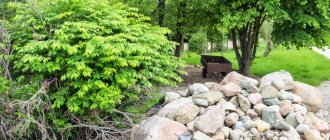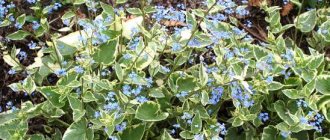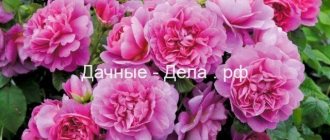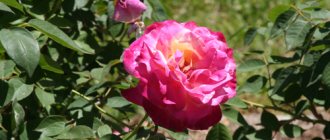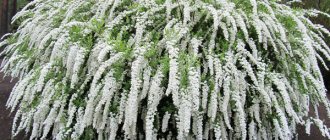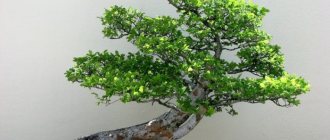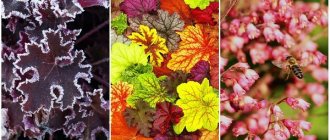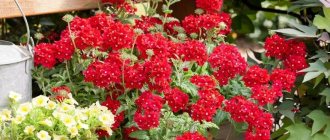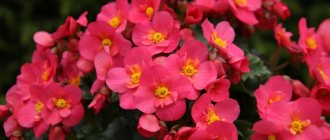A plant such as Brunnera or Brunnera is directly related to the genus of herbaceous perennial plants of the borage family. This genus includes 3 species. These plants are found naturally in Western and Eastern Siberia, the Caucasus and Asia Minor. This flower was named after the Swiss S. Brunner, who is known as a traveler and botanist. Only 2 types of brunnera are cultivated, namely: Siberian and large-leaved. These plants are most often used to create borders and for stable decorative groups as part of mixborders.
Options for using brunera in landscape design: photo options
The beauty of brunera lies in its wide green or silver leaves and small blue, white or dark blue flowers. The plant wakes up early in the spring: flowering begins in April and continues for 3-4 weeks. It can be combined with the same early flowering plantings: tulips, daffodils, muscari, hyacinths.
Brunnera is an indispensable plant for a shady or semi-shady area. It combines well with shade-loving hosts and astilbe. The plant is planted in mixborders, alpine slides, gardens in Japanese and Chinese styles. When planting in a mixborder, it is placed in the foreground, and it will highlight tall flowers.
How you can use the brunera flower in landscape design:
Description
Brunners are characterized by a thick rhizome, large broad-heart-shaped leaf blades, and pubescent branched stems. Small corollas are collected in loose paniculate or corymbose inflorescences.
- The pistil and stamens do not protrude.
- The fruits of the forget-me-not are small dry nuts. They appear by the end of August.
- The height of the perennial is from 45 to 55 cm. Its distribution area is Asia Minor and Siberia.
- The blooming corollas of Brunnera decorate the garden throughout the month. The flowering period occurs in April-May. Among the distinctive features is a white spot inside the flower.
- An adult plant forms low thickets that do not require complex care.
Additional advantages of brunners include their winter hardiness and visual attractiveness.
Popular varieties and types of Brunnera
In garden conditions, 2 types of brunnera are cultivated: large-leaved (Brunnera macrophylla) and Siberian (Brunnera sibirica). The first one looks the most impressive. The plant is winter-hardy, can withstand temperatures down to -30°C, so it can be planted in various regions, including the Moscow region.
Below are popular varieties of brunners with photos and names:
- Silver Hut (Silver Heart). This variety has beautiful silvery leaves. The veins and border have a rich green color. Silver Hut is undemanding to soil composition and can grow in direct sunlight.
- Variegata. The leaf blades of Brunnera Variegata have a white edge, the flowers are painted with a blue palette. The more sun that hits them, the larger and brighter the white area.
- Looking Glass. The leaves have a predominant silver tint. The veins are olive-silver, the flowers are blue.
- King's Ransom. The large heart-shaped leaves are light gray in color. Dark emerald veins are clearly visible on them. The bush is low-growing, barely reaching 20 centimeters.
- Jack Frost. The main background of the leaves of Brunnera Jack Frost is silvery, as if covered with frost. A thin green border is visible along the edges. Bushes require spraying once every 2 weeks.
Brunnera sibirica has heart-shaped, wrinkled basal leaves, growing on the stems - lanceolate. They are not painted as variegatedly and effectively as those of large-leaved
The positive qualities of crop cultivation include the following characteristics:
- decorativeness;
- shade tolerance;
- winter hardiness;
- ease of care;
- ease of reproduction.
Disadvantages include frequent damage to bushes under unfavorable conditions by powdery mildew and brown spot.
Brunnera Macrophylla - Forget-me-not
In German, the culture is called “Caucasian forget-me-not”.
Brunnera macrophylla, or Brunnera macrophylla, belongs to the genus Brunnera, family Buranchikov, or in Latin Boraginaceae. Another species found in the country, Brunnera sibirica, belongs to the same genus. These are herbaceous rhizomatous perennials.
Another name for Brunnera macrophylla is forget-me-not. His plant was awarded for the resemblance of its pale blue flowers to forget-me-nots. True, brunnera and forget-me-not bloom at different times.
Origin and appearance of Brunnera
The generic name Brunnera was given to the plant in the 19th century in honor of the doctor, traveler and naturalist from Switzerland Samuel Brunner. He traveled to different regions of the globe and wrote books in which he shared his observations, including the flora of certain territories. And the species name macrophylla translated from Greek means “large leaf” and reflects the size of the leaf blades.
- Forget-me-not is a perennial herbaceous plant that grows up to 50 cm in height.
- Branched, pubescent shoots extend from a long and thick rhizome.
- The leaves are few, large, broadly heart-shaped, sitting on long petioles. They have sharp tops and are dark green on top and grayish on the bottom. Their length reaches 25 cm.
- The rhizome of brunnera forget-me-not is thin, no more than 1 cm in thickness. It has a black-brown color and is located horizontally under the soil surface. Many adventitious filamentous roots emerge from it, extracting nutrients.
The plant is distributed in the western regions of the Ciscaucasia and Transcaucasia, as well as in the Kakheti region. It prefers subalpine meadows and shady forests.
For reference! In the European part of Russia, the Brunnera plant is found as an ornamental crop, which sometimes runs wild.
Description of the Brunnera flower
One of the popular varieties is Alexander Great.
The flowers of the large-leaved brunnera are small and dark blue in color. Their diameter does not exceed 7–10 mm. Outwardly, they resemble the more common forget-me-nots, but have a noticeable distinctive feature. The spot located inside the flower is not yellow, but white.
The flowers are collected in panicle inflorescences. They begin to bloom in April or early May. Flowering lasts about a month, sometimes repeated in the fall, if weather conditions permit. Small, black seeds ripen in June-July.
Landing
Brunnera can be grown from seeds at home and then planted in open ground.
Seeds
Seed material is purchased at a flower shop. In winter they are kept in the refrigerator, where they undergo stratification. In the spring, the seeds are sown in a box, and when a pair of true leaves appear on them, they are planted in separate containers. After hardening, bushes grown in containers are planted in open ground at the end of summer or early autumn.
Seedlings grown at home are planted in pre-dug small holes.
Planting plants in the ground
If a gardener wants to sow seeds directly into the ground, then he should do this in the fall. Over the winter they will naturally undergo a process of aging in cold conditions (stratification).
Planting brunneras in open ground
Planting and caring for brunnera in open ground is not difficult even for novice gardeners, if you follow a few rules.
Time to board
Why does paniculate, tree-like, large-leaved hydrangea not grow?
The optimal period for planting brunnera is July-August (after the plant has flowered). The culture no longer wastes energy on flowering and growth, but still has a sufficient supply of resources to adapt and continue development.
Advice. It is not recommended to replant flowers in the spring - at this time Brunnera is very sensitive to changes and may be susceptible to diseases or pests.
It is better to transplant in the evening or on a cloudy, cold day.
Landing place
The growing area is selected depending on the type of brunnera. The Siberian brunnera prefers heavy clay soils, while the large-leaved one prefers looser soils. The culture develops well in shaded areas and dries out in the sun. Can grow in sunny areas, provided there is a body of water nearby. If the planting site is in deep shade, then the plant loses its decorative effect, increases its green mass, and does not have time to prepare for winter. In addition, Brunnera does not tolerate drafts well; it is better to plant it in an area protected from the wind.
Step by step planting process
Brunner planting and care can be divided into main stages:
- Leaves and flower stalks are cut to a level of 1 cm above the soil.
- The bush is carefully dug up along with its rhizome.
- The roots are washed under running water.
- Damaged areas are removed.
- The root is divided along the line of collapse (it is important to ensure that there is at least one bud on the division).
- The soil is dug up and moistened abundantly.
- Holes 3-4 cm deep are prepared at a distance of 25-30 cm from each other.
- Divisions are planted in the holes, sprinkled with soil, lightly compacted, and watered abundantly.
Important! It is imperative to ensure that during planting the seedling does not go too deep into the ground - the root collar must be open, otherwise the plant will begin to rot.
Features of care
Brunnera is a moisture-loving plant, so it requires frequent and abundant watering. After planting, the trunk circle of bushes should be mulched with peat, compost or sawdust. This will retain moisture in the soil, and the mulch will also prevent the growth of weeds. The root system is close to the soil surface, so weeding is not recommended.
Spring care
In spring, bushes can be fed with nitrogen to actively increase green mass. When the buds begin to fade, the flower shoots are removed to maintain the decorative appearance of the plant.
Summer care
In the middle of summer, the leaves of Brunnera Siberia begin to dry out, so the entire above-ground part of the plant is removed during this period. In summer, the bushes can be fed with mineral fertilizers. By early autumn, young foliage appears.
in autumn
Some varieties of forget-me-nots may begin to bloom again in the fall. It is better to remove them, since flowering takes away a lot of the plant’s strength, which is necessary for successful wintering.
Growing Brunnera
Location
When placing varietal Brunner in the garden, you should choose a location where they will be illuminated by the morning rays of the sun and fall into the shade in the afternoon. In full shade, plants stretch out and lose their decorative appearance, and when grown in the sun, brunners need to ensure constant soil and air moisture, which is only possible if there is a reservoir. In hotter climates, planting them in full sun is generally not a good idea.
Soil for Brunnera
Brunnera sibirica prefers clayey, constantly moist soils. It grows very well on the north side of the house, where rainwater flows from the roof. With a lack of moisture, the leaves droop and by mid-summer the plant completely loses its decorative effect. For Brunnera macrophylla, a site with moderately moist soils is best suited. Too rich soils, especially those fertilized with fresh manure, cause active, prolonged growth of leaves, which disrupts the natural rhythm of seasonal growth and development characteristic of these species.
Brunnera care
It should be noted that Brunnera macrophylla, in which, as already noted, new leaves appear throughout the season, is decorative from spring to late autumn. After flowering, the leaves of Brunnera sibirica dry out quite quickly and become covered with brown spots, so it is better to cut them off in July. And already in mid-August new leaves grow, which last until frost. But neither of the brunneras have leaves that overwinter.
Caring for brunnera plantings is simple. In dense thickets of Brunnera sibirica, whose powerful rhizomes, intertwined, do not allow weeds here; care consists of cutting off leaves that have lost their decorative effect. In the conditions of Central Russia, properly planted in the shade and on moist soil, they do not need watering.
Brunnera macrophylla is less resistant to weeds. Its bush grows slowly, and weeds such as gooseberry, butterwort and other long-rhizome perennials can overwhelm it. Therefore, timely weeding is the basis for the good growth of this plant. It does not need watering or fertilizers. It is not recommended to loosen the plantings, since the rhizomes are located close to the surface.
Brunnera macrophylla 'Jack Frost'. © peganum
Reproduction
You can grow forget-me-not brunnera by seeds, dividing bushes, or pieces of rhizomes. Typically, the plant is propagated in the local area using the last two methods. Overgrown bushes are dug up, divided into parts, and planted in holes. Each plant divided into parts must have a rhizome and a flower bud.
For propagation by rhizomes, the root of the flower is dug up and divided into 5-6 cm sections. Rhizomes with buds are planted to a depth of 3 centimeters, watered and mulched. Flowering will occur next season.
Diseases and pests
The crop may suffer from powdery mildew and brown spot. Diseases most often occur when the summer is too wet or, conversely, dry. To prevent diseases, bushes are sprayed with fungicides.
If misfortunes have already appeared, then the above-ground part is first completely removed, and only then the soil is irrigated against the pathogenic microorganisms remaining in it. Among the pests, bushes can be favored by aphids and whiteflies. They get rid of them by spraying with Karbofos or Actellik.
Brunnera is an unpretentious plant, and there are usually no problems (except for the diseases and pests mentioned above). The bushes grow strongly, so they need to be planted in rock gardens with caution. You can restrain growth by inserting limiters around the perimeter.
Siberian brunella
Using Brunners
To create stable decorative groups as part of mixborders, it is good to use Brunnera macrophylla. Brunnera macrophylla can also be used in borders, since it does not grow, keeps its shape all season, its leaves are neat, and no diseases have been noted. It can also be used for planting in shady rockeries, but in their most humid part.
Brunnera sibirica is less valuable for flower beds, as it loses its decorative effect in mid-summer. But at the same time, this is not a capricious, quickly growing plant that forms a dense thicket (up to 50 cm in height) and is indispensable for decorating shaded, waterlogged areas in the depths of the garden or in the background of flower beds. Its advantages are rapid growth and stability. Growing does not require much time or expense.
Brunnera sibirica. © Vitaly Gumenyuk


